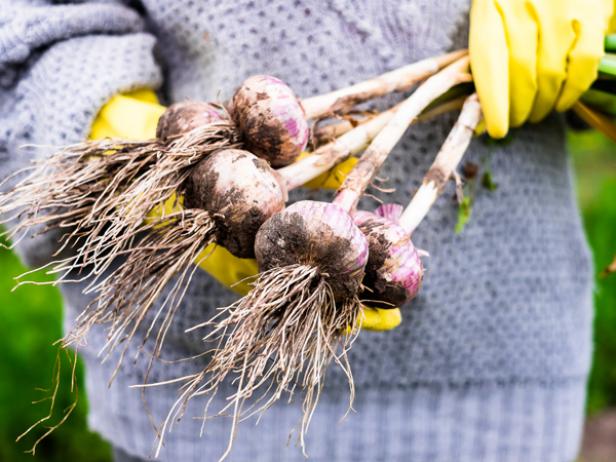Garlic planting season begins in October!
How to Plant Garlic | Grilling and Summer How-Tos, Recipes and Ideas : Food Network | Food Network
Calling all garlic lovers! Garlic season is here and is one of the easiest crops you can grow. It naturally repels most pests, requires little maintenance and rarely needs watering or fertilizing. Not to mention, the flavor it adds to many dishes all year long is nothing short of delicious!
In most regions of the country, garlic is planted in the fall and harvested the following summer. By the time fall rolls around, many summer crops have been harvested leaving free garden space for planting garlic. Once you have chosen a garlic bed for planting, keep in mind that the garlic bed won’t be available for another type of crop until late summer, after you’ve harvested your garlic.
Another important thing to remember is, the bed(s) require at least two, if not more, years in between successive planting to allow the soil to recover. So, every season, choose a different garlic bed for planting; this is called crop rotation. Keep your crop rotation organized and stress-free by documenting where you planted each year.
Here’s how to get your own personal garlic crop going.

Anna Kurzaeva/Getty
Purchasing Your Garlic
Not all garlic is created equal. If you’re planning to purchase garlic, look for garlic that is organic and is specifically sold as seed for planting. Garlic at your local grocery store may have been treated with a sprout inhibitor to prevent it from growing.
Reaching out to a local organic farmer who sells garlic is a great option when looking to grow your own.
Once harvested the following summer, you will have your own garlic seed for replanting every year.
If you’re replanting your own garlic stock, choose the biggest and best bulbs from your summer harvest. Every one clove planted in fall will turn into one bulb the following summer.
Choosing Your Garlic Variety
There are several varieties of garlic which are broken up into two categories: Hardneck and Softneck. Each has its own strengths and place in the culinary world. The “neck” refers to the stock that grows upward from the garlic bulb. Let’s take a look at both.
Hardneck Garlic
This variety produces the edible flower stem called the garlic scape. A delicacy that can be added to many dishes and has a mild garlic flavor. Out of the two, Hardneck has a sharper and more complex flavor than Softneck varieties. Hardnecks are hardy, making them a good choice for regions with colder winters. They are also known for their stiff stem that grows up from the bulb and produces larger cloves per bulb.
Softneck Garlic
The best choice for those with mild winters, the Softneck variety is the type of garlic you’ll find at most supermarkets. They don’t have a stiff central stem or produce garlic scapes, and produce several smaller cloves per bulb. They do however mature more quickly than Hardneck varieties.
Now that you’ve chosen the variety that’s best for you and your location, it’s time to get planting.
Let’s Plant!
Each single clove of a garlic bulb is an individual clove/seed. Once planted, it will then grow into a full bulb.
- Plan to plant your garlic about 10 to 14 days before the ground freezes so the roots can form in the earth.
- Choose a sunny, well-drained area to plant your garlic.
- Prepare your soil by loosening it to a depth of about 8 inches and add an all-purpose organic fertilizer into the soil, top dress with compost.
- Before planting, break up garlic heads into individual cloves, leave the paper wrapper on each clove.
- Plant the cloves four inches deep, wide side down and pointy tip-up. Space each clove about five inches apart. To get the correct planting depth, mark a piece of wood at four inches to be exact.
- Once your cloves are in each hole, gently cover with dirt, and then cover with six inches of straw. This will help protect your garlic this winter as it grows.
- Once green tips emerge in the spring, apply one boost of nitrogen fertilizer and the rest will take care of itself. Remember to cut scapes if growing a Hardneck variety when they appear.

